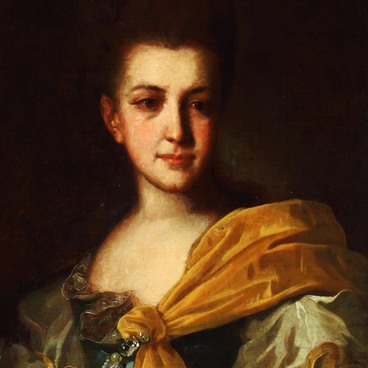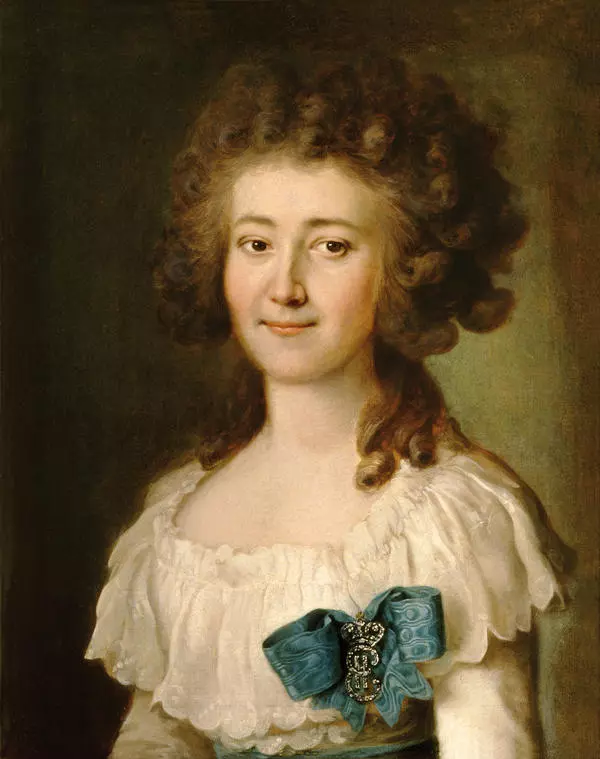Yermolay Kamezhenkov, a Russian master of the portrait genre, was born in 1757 into a serf family living on a territory of contemporary Tver Oblast. He studied icon-painting in his youth and displayed such an amazing ability that he was sent to Petersburg to continue his studies. In the capital, he studied under Gavriil Kozlov, a major historical and portrait painter.
In Petersburg, Kamezhenkov’s works were seen by Catherine II, who liked them and consequently asked him to copy a couple of masterpieces from the collection of Hermitage. The Empress was very happy with a young painter’s works, even to the extent of freeing him from serfdom in 1785. Subsequently, he had received the title of academician of the Imperial Academy of Arts in 1794.
This portrait of Yakov Likhachyov, a Russian commander from the Napoleonic wars, was painted by Kamezhenkov in 1792. Likhachyov is depicted in a green uniform of the Semyonovsky Regiment shortly after his promotion to the rank of Podporuchik, outranking his elder brother. The painting clearly shows that he posed for the painter with undisguised pride. Despite this portrait being ceremonial, Likhachyov poses in an open and relaxed way. The background has military equipage on a stand (a rifle and a headdress).
Likhachyov’s career evolved at a rapid pace: eight years after the painting of this portrait, in 1800, he led the Suzdal Musketeer Regiment as a major-general. A year later, he became one of the commanders of the Semyonovsky Regiment. In 1805, he was badly wounded during the Battle of Austerlitz against the Napoleonic army and soon retired from service. However, he led the Yaroslavl People’s Militia during the Patriotic War of 1812, and participated in the War of the Sixth Coalition in 1813-14, finishing his military career afterwards.
Likhachyov was honored by many blue ribbons for his exemplary service: he is a bearer of the Order of St. Vladimir, the Imperial Order of Saint Anna, and the Order of Saint John of Jerusalem. However, he is famous not only for his military gains: he founded the Sosnovets manor in Poshekhonsky District in Yaroslavl Province. It was built on a large scale: the big house, several outbuildings, the poultry yard, the stable yard and even the big distillery were all built there. The manor is currently neglected.
In Petersburg, Kamezhenkov’s works were seen by Catherine II, who liked them and consequently asked him to copy a couple of masterpieces from the collection of Hermitage. The Empress was very happy with a young painter’s works, even to the extent of freeing him from serfdom in 1785. Subsequently, he had received the title of academician of the Imperial Academy of Arts in 1794.
This portrait of Yakov Likhachyov, a Russian commander from the Napoleonic wars, was painted by Kamezhenkov in 1792. Likhachyov is depicted in a green uniform of the Semyonovsky Regiment shortly after his promotion to the rank of Podporuchik, outranking his elder brother. The painting clearly shows that he posed for the painter with undisguised pride. Despite this portrait being ceremonial, Likhachyov poses in an open and relaxed way. The background has military equipage on a stand (a rifle and a headdress).
Likhachyov’s career evolved at a rapid pace: eight years after the painting of this portrait, in 1800, he led the Suzdal Musketeer Regiment as a major-general. A year later, he became one of the commanders of the Semyonovsky Regiment. In 1805, he was badly wounded during the Battle of Austerlitz against the Napoleonic army and soon retired from service. However, he led the Yaroslavl People’s Militia during the Patriotic War of 1812, and participated in the War of the Sixth Coalition in 1813-14, finishing his military career afterwards.
Likhachyov was honored by many blue ribbons for his exemplary service: he is a bearer of the Order of St. Vladimir, the Imperial Order of Saint Anna, and the Order of Saint John of Jerusalem. However, he is famous not only for his military gains: he founded the Sosnovets manor in Poshekhonsky District in Yaroslavl Province. It was built on a large scale: the big house, several outbuildings, the poultry yard, the stable yard and even the big distillery were all built there. The manor is currently neglected.


